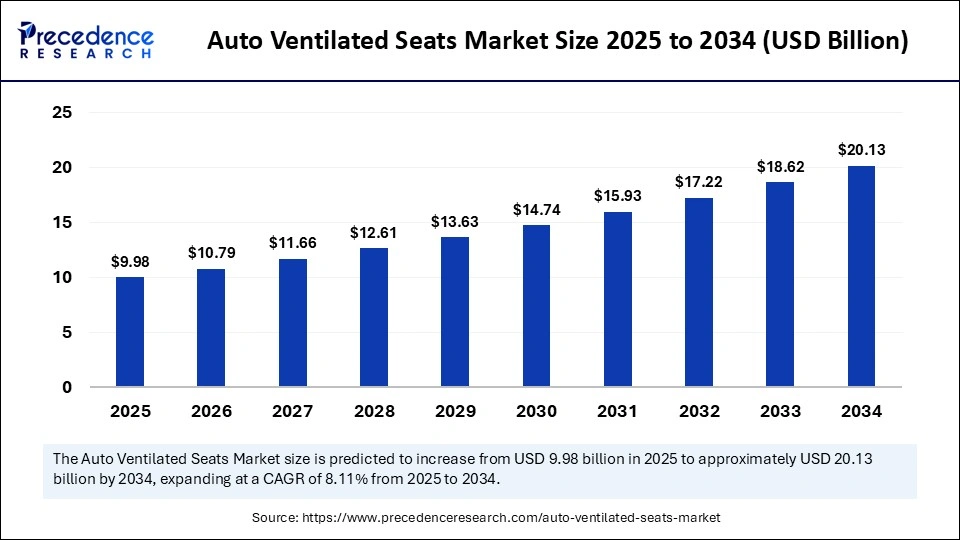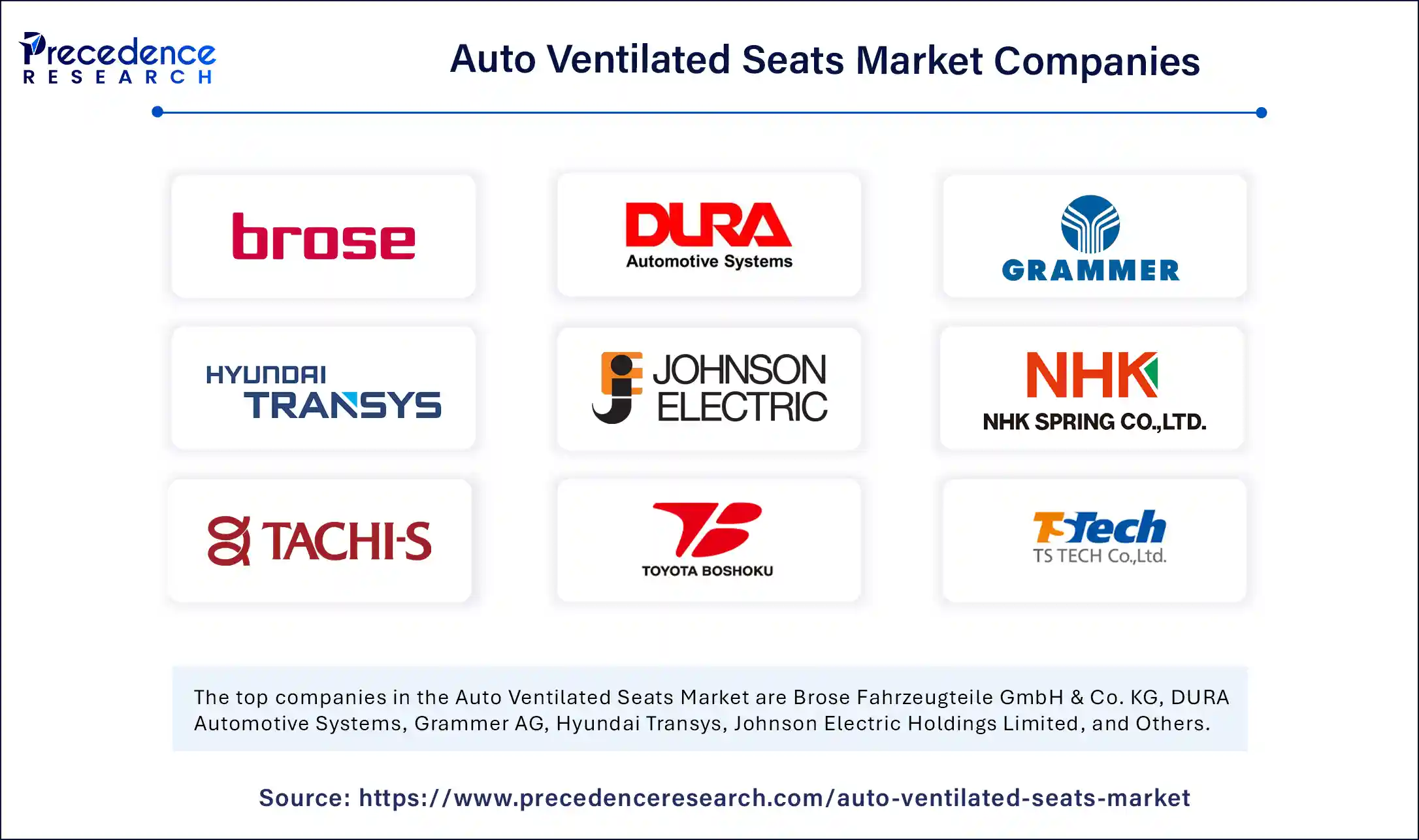Auto Ventilated Seats Market Size to Surpass USD 20.13 Billion by 2034

Auto Ventilated Seats Market Key Takeaways
In terms of revenue, the auto ventilated seats market is valued at $9.98 billion in 2025 and is projected to reach $20.13 billion by 2034, growing at a CAGR of 8.11% from 2025 to 2034. North America held the largest share of the global auto ventilated seats market in 2024, while the Asia Pacific region is expected to experience the fastest growth during the forecast period.
By vehicle type, luxury cars accounted for the major revenue share in 2024, whereas the mid-size cars segment is anticipated to grow at a notable CAGR in the coming years. On the basis of end-user, the OEMs segment contributed the highest market share in 2024, with the aftermarket segment projected to grow at the fastest CAGR from 2025 to 2034. In terms of fan type, axial fans dominated the market in 2024, while the radial fan segment is forecasted to witness the highest CAGR over the projected period.
Impact of Artificial Intelligence on the Auto Ventilated Seats Market
Artificial intelligence (AI) is essential for advancing auto ventilated seat technology since it allows systems to act more wisely. Rather than letting passengers use basic manual features, AI-powered ventilated seats help control the air by reading temperature, humidity, and passenger choices. Adaptive systems add comfort for drivers during long trips or very cold or hot weather and save energy at the same time. Additionally, major automakers are introducing AI technology to help the seats handle user needs much better by studying the actions or surroundings of the driver.
Market Overview
The auto ventilated seats market is gaining significant momentum as vehicle buyers increasingly prioritize cabin comfort and technology-enhanced driving experiences. These seats, designed with integrated airflow systems and high-breathability materials, offer relief from heat buildup and improve driving ergonomics. Once considered a high-end feature reserved for luxury vehicles, ventilated seats are now expanding across mid-size car segments, driven by consumer demand for wellness and convenience features.
Automakers and Tier 1 suppliers are innovating in fan designs, air duct integration, and energy-efficient materials to optimize performance and minimize bulk. As the automotive industry shifts toward electrification and smart interiors, the auto ventilated seats market is positioned as a key segment of the evolving in-cabin experience strategy, supporting both premium and mainstream vehicle trends.
Drivers
The auto ventilated seats market is being propelled by a combination of consumer lifestyle changes and evolving vehicle design standards. Rising temperatures due to global climate change have amplified the need for efficient cabin climate control systems, with ventilated seating offering a practical and efficient solution. Consumers are spending more time in their vehicles—commuting, traveling, or using vehicles as mobile offices—making comfort an essential factor.
Furthermore, the growing influence of the Internet of Things (IoT) in automobiles has introduced connected seating systems, where ventilation levels can be personalized through apps or synced with in-car climate settings. The rise in disposable income across emerging economies is also enabling more customers to afford vehicles equipped with premium features, boosting demand across a broader demographic range in the auto ventilated seats market.
Opportunities
There are numerous opportunities for innovation and expansion in the auto ventilated seats market. One major opportunity is the application of smart materials and adaptive technology, such as seats that automatically regulate airflow based on body temperature or ambient humidity. These innovations not only improve user experience but also enhance energy efficiency, which is particularly critical for electric vehicles where energy management is paramount.
The aftermarket sector presents another major opportunity, especially in mature markets where consumers seek to retrofit their existing vehicles with comfort-enhancing features. Furthermore, there is increasing potential in the development of sustainable seat components, including eco-friendly foams, breathable fabrics, and recyclable materials that align with automakers’ sustainability goals. As more vehicle brands strive to meet carbon neutrality targets, the integration of environmentally responsible ventilated seat systems will become a key differentiator in the auto ventilated seats market.
Challenges
Despite strong growth prospects, the auto ventilated seats market faces several challenges. One of the most significant issues is the high cost associated with the development and integration of ventilated seat systems. These costs can be prohibitive for economy or entry-level vehicle segments, limiting market penetration. Furthermore, maintaining consistent ventilation performance across different body types, driving conditions, and vehicle models requires complex design customization, which can delay product development cycles. Another challenge is related to energy consumption, particularly in electric and hybrid vehicles where energy-efficient systems are essential.
Balancing comfort with low power draw remains a key engineering hurdle. The market also faces technical difficulties such as airflow noise, potential seat wear over time, and integration with heating systems without compromising seat material longevity or performance. Additionally, the lack of awareness and standardization in some regional markets may hinder faster adoption of ventilated seating technology.
Regional Insights
The auto ventilated seats market shows strong geographical variance, influenced by climate, consumer preferences, and vehicle mix. North America leads the global market, driven by a well-established luxury vehicle segment, a strong focus on comfort, and the presence of advanced OEMs offering ventilated seating as standard or optional in numerous models. Europe, with its emphasis on premium vehicles and luxury features, continues to expand its share, particularly in Germany, France, and the UK.
However, Asia Pacific is expected to exhibit the fastest growth rate due to rising middle-class incomes, growing car ownership, and increasing integration of comfort technologies in domestic and foreign vehicle brands. Countries like China, South Korea, and India are emerging as major markets, supported by high-volume vehicle manufacturing and rising demand for mid-size cars with enhanced interior features. Meanwhile, Latin America and the Middle East are gradually adopting ventilated seats in their luxury and SUV segments as consumers seek improved driving comfort in hot climates.
Recent Developments
Recent developments in the auto ventilated seats market are redefining the future of automotive seating. Companies are focusing on modular seat architectures that allow for easier integration of both heating and cooling functions without compromising on seat design. Newer fan technologies, such as micro axial and radial units, are being introduced to reduce noise and improve efficiency. Several manufacturers have also unveiled AI-enabled seats capable of adjusting ventilation levels based on detected body temperature or motion data.
The push for electrification has led to partnerships between seat suppliers and EV manufacturers to co-develop low-power ventilated seats that integrate seamlessly with battery management systems. Furthermore, Tier 1 suppliers are investing in digital twin technology to simulate airflow and optimize seat design during the development phase, reducing time-to-market. These innovations are not only enhancing user comfort but also helping automakers offer more intelligent and sustainable vehicle interiors, further driving demand in the auto ventilated seats market.
Auto ventilated seats market Companies

- Brose Fahrzeugteile GmbH & Co. KG
- DURA Automotive Systems
- Grammer AG
- Hyundai Transys
- Johnson Electric Holdings Limited
- NHK Spring Co., Ltd.
- TACHI-S Co., Ltd.
- Toyota Boshoku Corporation
- TS Tech Co., Ltd.
- Woodbridge Foam Corporation
Segments Covered in the Report
By Vehicle Type
- Economy Cars
- Mid-size Cars
- Luxury Cars
By End User
- OEMs
- Aftermarket
By Fan Type
- Axial Fan
- Radial Fan
By Region
- North America
- Europe
- Asia Pacific
- Latin America
- Middle East and Africa
Get Sample Link@ https://www.precedenceresearch.com/sample/6210
